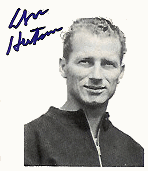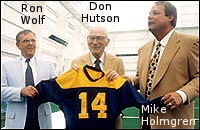Donald Montgomery Hutson ...
Mr. Hutson, the "Alabama Antelope", was a football All-American at Alabama in 1934. He then went on to forever change the game of Football.
Research on Mr. Hutson, the pipe smoking bowling alley proprietor, led us to a ducky article by Mr. David Whitley of the Orlando Sentinel. He granted us permission to reprint his article here, and we are pleased to be able to. All copy is courtesy of David Whitley, while pictures are courtesy of GreenBayAntiques.com.
Without further ado ...
Hutson was first modern receiver
By David Whitley, Orlando Sentinel

Before there was Jerry Rice, before there was Steve Largent, before there were even pass patterns, there was Don Hutson.
He was a receiver ahead of his time by a half-century. That's how long it took for the National Football League to catch up with the "Alabama Antelope." Hutson didn't merely catch more passes and score more touchdowns than anybody imagined possible. He changed the way football was played.
Few teams threw the ball in 1935 unless they were desperate or wanted to surprise the opponent. Hutson was football's Copernicus, proving that the universe did not revolve around the run.
By the time he retired in 1945, passing was part of the game. As for the receiving part, nobody played the game like Hutson. Statistically, his only rivals weren't born when Hutson left the game.
He led the NFL in touchdowns eight times. More than 50 years later, nobody else has led the league more than three times.
He also led the league in catches a record eight times, including 1942, when he had a then-astonishing 74 receptions. His nearest rival caught 27 passes that season.
In nine seasons he was the top touchdown receiver in the league (Rice is second all-time with six). Amazingly, not only is Hutson listed first for most consecutive years (five) leading the NFL in touchdown catches, he also is second with four.
Hutson finished his career with 99 touchdown receptions, an astounding 62 TDs ahead of his closest competitor. Largent finally broke Hutson's record 44 years later. Largent, Rice and other modern-day receivers simply traced the footsteps that Hutson blazed.
He began setting records when the NFL had nine teams and little offensive imagination. It was single-platoon football, and Hutson had 23 interceptions in his final four seasons as a defensive back. He also scored 193 career points as a place-kicker.
Hutson retired with 488 receptions and 7,991 yards. The second-place receiver had 190 catches and 3,309 yards. Hutson played in an era of 10- to 12-game seasons, so his records might have stood forever if he had the 16-game opportunities enjoyed today. As it was, Hutson was still an obvious choice to be a charter member of the Pro Football Hall of Fame in 1963.
"I love to see my records broken, I really do," he said in 1989. "You get a chance to relive a part of your life, the whole experience."
Hutson was born on Jan. 31, 1913, in Pine Bluff, Ark. As a Boy Scout he played with snakes. He said that's where he got his quickness and agility. While he didn't start for Pine Bluff's high school football team until his senior year, he was a star in baseball.
He came to the University of Alabama on a partial baseball scholarship and was an outstanding centerfielder. He also ran track. But it was on the gridiron that Hutson made his most lasting impression. A walk-on, he became an All-American end in 1934.
In the 1935 Rose Bowl, he caught six passes for 165 yards and two touchdowns in Alabama's 29-13 victory over Stanford.
"Don had the most fluid motion you had ever seen when he was running," said the other end on that Alabama team, some player named Bear Bryant. "It looked like he was going just as fast as possible when all of a sudden he would put on an extra burst of speed and be gone."

Hutson was 6-foot-1 and 185 pounds when he showed up in Green Bay in 1935, and people wondered if he could take the pounding of pro football. Defenders weren't limited to a five-yard zone in which they could legally hit a receiver back then. It turned out, the pounders were the ones in trouble.
The only reason he was in Green Bay was because most of the other coaches in the league thought he was too fragile. The Chicago Bears were the first team to change their mind, in the Packers' second game of 1935.
Before a crowd of 13,600 at City Stadium, on the first play from scrimmage, Green Bay quarterback Arnie Herber threw a pass deep downfield. Beattie Feathers, Chicago's defensive back, was sure it was out of everyone's reach. Then a rookie flew past him, caught the ball without breaking stride and scored the game's only touchdown in a 7-0 Packer win.
Defenses couldn't contain Hutson. He ran a 9.7 100-yard dash and could shift and shake. His precise routes were revolutionary. Defenses began double and triple-teaming him, concepts that were unheard of at the time.
"He would glide downfield," Packers coach Curly Lambeau said, "leaning forward as if to steady himself close to the ground. Then, as suddenly as you gulp or blink an eye, he would feint one way and go the other, reach up like a dancer, gracefully squeeze the ball and leave the scene of the accident -- the accident being the defensive backs who tangled their feet up and fell trying to cover him."
They kept falling over themselves for 11 seasons.
"Hutson Does It Again!"
"Don Paces Packers to World Title!"
"Amazing Hutson Can't Be Stopped!"
Those were the headlines Green Bay fans were treated to during the World War II era. Perhaps Hutson's greatest performance came on Oct. 7, 1945. He caught four touchdown passes and kicked five extra points -- in one quarter. The 29-point quarter is a record that may never be broken.
"He had all the moves," said teammate Tony Canadeo. "He invented the moves. And he had great hands and speed, deceptive speed. He could go get the long ones; run the hitch, the down-and-out. He'd go over the middle, too, and he was great at getting off the line because he always had people popping him."
In that era, sportswriters usually did not get comments from players. That was fine by Hutson, a humble man who liked to let his feats speak for themselves.
About his 29-point quarter, he later recalled, "Well, the wind was blowing hard and straight downfield, and you couldn't throw the ball 20 yards the other way. Those defenders just couldn't get that in their heads, that's all."
The weather always seemed to work in his favor. Like the afternoon he had 14 catches against the New York Giants, or 237 receiving yards against Brooklyn. Hutson caught passes in 50 straight games from 1941-45.
Twenty percent of all his receptions were touchdowns. He scored a total of 105 touchdowns in just 117 games. The Packers won three NFL championships (1936, `39 and '44). He retired with 19 NFL records, was named to the all-pro team in 8 of his 11 seasons and was NFL MVP in 1941 and '42.
Following his retirement as a player, Hutson was an assistant coach for the Packers under Lambeau for three seasons (1946-48). He served on the club's board of directors from1952-80, when he was elected a director emeritus.
When the Packers built their indoor practice facility in 1994, they needed a name. Despite the many great names that played for the storied franchise, there was never any doubt which athlete the place would honor.

It was christened the Don Hutson Center.
"I don't know if there is such a thing as royalty in professional football," said Packers general manager Ron Wolf as he stood next to Hutson at the dedication ceremony, "but this is the closest I've ever come to it."
The king of receivers died three years later, on June 26, 1997, at age 84. At the time, he still held 10 NFL records and 18 team marks.
"He most certainly was the greatest player in the history of this franchise," Wolf said. "In the era he played, he was the dominant player in the game."
